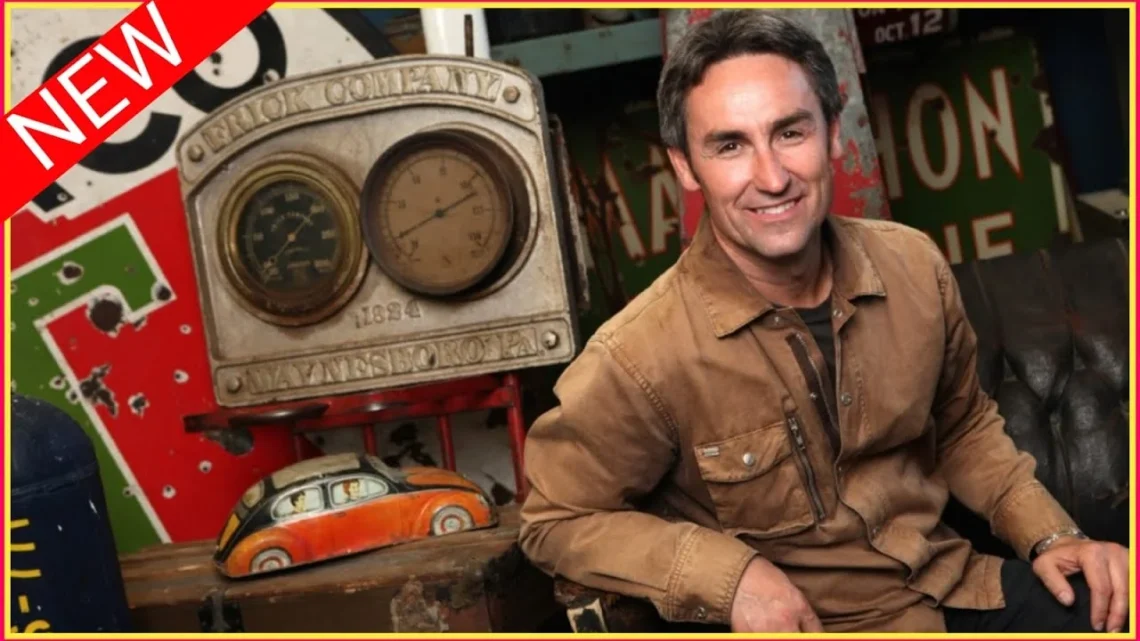Who Is Mike Wolfe and What Sparked the Passion Project
Mike Wolfe is a familiar name for many—particularly those who love antiques, Americana, and stories hidden in rust and decay. He became nationally known as one of the stars and co-creators of American Pickers, a History Channel show launched in 2010 that follows Wolfe (and originally Frank Fritz) as they travel across the U.S., acquiring forgotten relics, vintage items, and unusual artifacts.
From the outset, Wolfe’s public identity was more than just “picker of old stuff.” He has always stressed that antiques and collectibles are about stories—who owned them, what they meant, what era they come from. Over the years, as his visibility and resources increased, he had greater capacity to go beyond single items and large-scale picking: to preserve places, architecture, and community heritage. That shift— from gathering relics to saving and restoring space and history—became what many refer to now as his Passion Project.
Wolfe’s transition into preservation is rooted in his love of rural America, small-town charm, and a conviction that the built environment (old buildings, Main Streets, vintage bikes, signs) carries knowledge and identity that should not be lost. As he has said in interviews, seeing deteriorated buildings or places that once meant more to people – those spark something in him. With more means, he set out to act on that instinct.
The Core Mission of the Mike Wolfe Passion Project
At its heart, the Passion Project revolves around a few tightly linked goals:
Preservation of Historical Architecture and Buildings
One major pillar is saving and restoring structures—old gas stations, storefronts, bunting-board homes, industrial service garages, buildings with tin ceilings, beadboard, architectural character. Wolfe seeks to bring them back to life not as museums stuck in time, but as functional spaces serving present-day needs (shops, gathering places, restaurants, Airbnb-type guesthouses) while retaining authenticity.
Storytelling & Americana Artifacts
The other pillar is the object/history side: antiques, motorcycles, signs, relics of roadside culture, little stories behind people and places that have been neglected. Wolfe’s background in picking feeds directly into this. Not just what things are worth, but what they meant, how they reflect identity, economy, people’s lives. These stories live through his stores (Antique Archaeology), his brand (Two Lanes), his digital content, etc.
Community, Artisans, Cultural Revival
Wolfe’s project isn’t solo. It involves communities—towns like LeClaire, Iowa; Columbia, Tennessee; craftsmen, makers, traditional trades people. He tries to give back: support local economy, preserve not just buildings but skills (metalworking, sign painting, woodworking etc.), create gathering places, and stimulate heritage tourism. The aim is cultural revival: helping towns revalue what was often taken for granted.
Key Components and Ventures
To realize the mission, Wolfe has built multiple interlocking ventures and platforms. Below are major ones.
Two Lanes: Journal, Shop, and Brand
-
Two Lanes is more than just a shop. It’s a lifestyle brand / visual journal. The name nods to the quieter, rural roads of America. On Two Lanes, Wolfe shares stories, photographs (motels, roadside relics, small towns), interviews with artisans, and sells curated goods—handmade, vintage, or inspired by Americana.
-
It helps tie together the restoration side, the storytelling, and the commercial side (funding, sustaining the project). The value of Two Lanes is that it gives people a way to engage—buy something, read something, see something, contribute. It widens the audience beyond TV watchers.
Antique Archaeology Stores
-
His brick-and-mortar stores (notably in LeClaire, Iowa, and formerly in Nashville) serve dual purposes: retail outlets and museums / display spaces. They aren’t just places to buy antiques; artifacts are curated, show their histories, connect visitors to stories.
-
The stores help sustain the financial side of restoration, as well as serve as touchpoints for community engagement and tourism. Many people visit them when traveling small towns. The visibility amplifies Wolfe’s message of preserving heritage.
Columbia, Tennessee Restorations & Columbia Motor Alley
-
Columbia, Tennessee is one of Wolfe’s major bases for his restoration work. He has acquired and restored multiple historic buildings there—old gas stations, industrial garages, historic storefronts. One project is “Columbia Motor Alley,” which revives an old industrial strip, turning it into a creative hub for vintage vehicle display, maker studios, markets, etc.
-
Another is turning derelict properties into spaces like restaurants (e.g., the restored Esso gas station turned into “Revival” restaurant / community space) and guesthouses. These restorations aim to preserve character (architectural details, materials) while giving them functional use.
Guesthouses, Hospitality, and Immersive Spaces
-
Wolfe’s work includes converting historic properties into guesthouses. For instance, in Columbia, Tennessee, there is Two Lanes Guesthouse—a hospitality venture that allows visitors to literally stay in restored Americana, experiencing the textures, architecture, stories of old places in the most immediate way.
-
These immersive experiences help people not just see, but live in history for a moment, making the restoration affect more deeply felt, more emotional, more appreciated. They also help with sustainability: tourism, rental income, more visibility, etc.
Featured Projects
Here are several standout projects that illustrate how the Passion Project works in practice, including challenges, results, and stories.
Restoring storefronts in LeClaire, Iowa
-
LeClaire is Wolfe’s hometown base (his flagship Antique Archaeology is there). He has purchased and restored several historic storefronts from the 1880s there. These are used for his stores and also as workshop / community gathering spaces. The idea is preserving downtown LeClaire’s character, enhancing its appeal to locals and visitors alike.
-
His involvement extends beyond aesthetic: maintaining original features (woodwork, facades, signs), keeping the heritage in visible form. The effect is both physical and symbolic: that LeClaire values its past.
Reviving Main Street in Columbia, Tennessee
-
Columbia has become a focal point for Wolfe’s passion: multiple building purchases, restorations, transforming derelict spaces into shops, gathering spots, events, etc. Motor Alley is part of that. Reviving “Main Street America” kind of identity: storefronts, pedestrian-friendly spaces, local artisans, place for people to meet.
-
Public spaces and community uses matter: cafés, markets, outdoor seating, retaining character of gas stations, old garages, etc. The restored Esso gas station (turned into Revival) is a good example.
The “Revival” restaurant & restored Esso gas station project
-
One recent project is converting a historic Esso gas station into “Revival,” a restaurant/community space. This is a prime example of how restoration, architecture, community-use and aesthetic converge. It keeps the automotive and gas-station history, uses it as memory, yet repurposes it for people to gather today.
Restoration of vintage motorcycles & Americana relics
-
Wolfe isn’t just restoring buildings; he also restores vehicles (classic motorcycles, old Indian motorcycles etc.), vintage signs, relics that symbolize culture, machine history, roadside culture. These restorations are both museum-like displays and functional (sometimes rides, demonstrations, exhibitions).
-
One famous example: restoring a 1937 Indian motorcycle original paint etc. Wolfe has posted about these works, connecting the object not just to mechanical function but to people’s memories.
Impact on Communities & Economics
Mike Wolfe’s Passion Project is about more than nostalgia. It has measurable, real effects: economic, social, cultural.
Heritage tourism & economic growth
-
Restored historic districts and buildings attract visitors. People interested in Americana, history, vintage feel travel to small towns, especially when there are interesting places like Antique Archaeology, or restored Main Street storefronts or community hubs. This influx benefits restaurants, lodging, local shops.
-
In Columbia, Tennessee, these projects have boosted foot traffic, new business openings, visible revitalization of downtown, etc.
Small business incubation & artisans’ support
-
Wolfe’s project supports artisans, craftsmen, makers: giving exposure, sometimes financial support or space (workshops, studio rentals), featuring their goods in Two Lanes or shops. These small makers often can’t compete in a global mass-production environment; Wolfe helps preserve their crafts and livelihoods.
-
Also, buildings are sometimes repurposed into spaces where multiple artisan businesses can co-exist: maker studios, pop-ups, markets. That spreads economic benefit.
Job creation & skilled trades preservation
-
Restoration requires skilled labor: masonry, carpentry, historic restoration of architectural details, sign-painting, vintage vehicle mechanics, etc. These are skills that are less in demand in mass new construction or generic refurbishing. Wolfe’s projects help preserve and employ those skills.
-
Also, through hospitality (guesthouses, restaurants), retail, tourism, there are indirect jobs (service, maintenance, local supply chains etc.). The multiplier effect is significant.
Philosophies and Principles
What makes Wolfe’s Passion Project distinctive is not just what he does but how he does it—the philosophies behind the work.
Preservation over demolition or replacement
-
Wolfe tends to favor adaptive reuse rather than tearing old buildings down and putting up generic new ones. He maintains or restores original features: woodwork, tin ceilings, original signage, architecture. The idea is: preserving what already exists is valuable in itself.
-
The environmental dimension: repurposing materials, reducing waste, conserving embodied energy in the fabric of old buildings, rather than demolishing and building anew.
Authenticity and keeping original character
-
Wolfe’s restorations don’t aim for polished, slick, homogeneous modern style. They try to keep quirks: original paint, patinas, structural quirks, signs of age. He believes these “imperfections” are part of history.
-
The artifacts in his stores are not shown merely as “decor.” They are contextualized; their story, provenance, cultural background are highlighted. That helps preserve meaning, not just form
Sustainability and repurposing
-
Besides environmental sustainability through reuse, the project is sustainable in its model: mixing commercial with cultural, generating revenue from retail, shops, guesthouses, events so that maintenance and expansion is feasible. Not purely philanthropic or relying on donations.
-
Repurposing uses: guesthouses, restaurants, community spaces, maker studios, etc., so building continues to be useful, and community benefits flow.
Outreach, Media & Education
Wolfe’s Passion Project is not hidden in the background; much of its influence comes through media, education, and public engagement.
Digital storytelling (blogs, Two Lanes, social media)
-
The “Two Lanes” platform plays a big role: through photography, essays, interviews, product curation, Wolfe engages a wider audience who may never visit Columbia or LeClaire but can learn about small-town America, vintage culture, etc.
-
Visual content (pictures of motels, roadside signs, motorcycles) has strong appeal. Wolfe leverages social media, likely YouTube, Instagram etc., to share restoration process, behind-the-scenes, stories. This builds awareness, support, possibly funding.
Workshops, school partnerships, local historical societies
-
He collaborates with local historical societies, maybe schools, to teach preservation, talk about heritage. Those outreach efforts help build local ownership of history: that residents of towns become invested.
-
Workshops might cover restoration techniques, vintage restoration, traditional crafts (sign painting, metal work etc.). These help pass on skills that are often fading.
Media: TV, exhibits, public events
-
Of course, the original impetus (and public platform) was American Pickers. That show helps Wolfe’s credibility, visibility, and network. It’s where many got introduced to objects, stories, his perspective
-
He uses public events: pop-ups, anniversaries, open houses in restored buildings, grand reopenings, etc. These events bring people in, generate buzz, build a sense of community involvement. E.g. when Columbia Motor Alley reopened, that drew attention.
Challenges and Criticisms
Even with strong successes, there are real challenges and some criticisms that any project like this must contend with.
Scaling and Resource Demands
-
Restoration is expensive. Historic buildings often need infrastructure upgrades (plumbing, electrical, insulation, hazard removal, etc.) which can add cost. Time, labor and materials are often limited. Wolfe depends on both financial investment and skilled craft labor. Scaling up to many towns/sites means scaling those resources
-
There may be legal, zoning, environmental regulations that complicate restoration. Not all old buildings are easily salvageable or permitted for new uses. Preserving authenticity sometimes conflicts with modern codes.
Balancing Commercial Viability with Authenticity
-
For restored buildings to be usable, often modern amenities must be added. That runs the risk of diluting character. Striking balance between safety / comfort / profit (if hotel, restaurant) and preservation is delicate.
-
Retail and hospitality ventures must make enough revenue to sustain maintenance. If costs escalate unforeseen, projects can become financially burdensome.
Avoiding Gentrification or Displacement
-
Reviving small towns can sometimes raise property values, rents, cost of living, which risks displacing longtime residents or local businesses who cannot afford rising costs. Maintaining affordability is a concern.
-
Also, there is tension between attracting tourists (which often drive aesthetic restoration) and preserving the lived character of place (which includes less polished or “declining” portions).
Public Perception & Prioritization
-
Not everyone values historic architecture or antiquities. Some may prefer new development, modern convenience, or see old buildings as liabilities. Convincing towns, investors, local governments that restoration is worth the investment is an ongoing effort.
-
Also, some may criticize Wolfe or similar people for being nostalgic, or for deciding what gets preserved (which narratives, which buildings). There are biases in which stories are preserved and which histories are valorized.
Mike Wolfe’s Future Vision & What’s Next
Based on what’s public as of 2025, Wolfe is not slowing down; instead, many of his goals suggest expansion, refining, experimenting.
Expansion goals, more states / restoration projects
-
Wolfe seems to aim to restore historic buildings in more places—not just in Tennessee or Iowa, but in new towns across America. The idea of saving one historic building in every state by a target date is being discussed in some media.
-
The more projects, the higher complexity. But also the more stories, the wider community involvement, and greater cumulative cultural value.
New media / new formats
-
While American Pickers remains a foundational platform, Wolfe’s media output is diversifying: more documentaries, possibly new shows with different formats (e.g. archival stories, live events, behind-the-restoration, immersive content).
-
The digital space (e.g. Two Lanes) will likely remain crucial—blogs, photo essays, possibly VR/virtual tours of restored places or vintage collections.
Deeper Artisan Grants, Community Involvement
-
More systematic support of craftspeople: grants, studios, apprenticeships. Wolfe’s work already includes supporting small makers, but scaling that support helps preserve skills long-term.
-
Engaging local governments, public policy, heritage nonprofits to create policy frameworks, incentives, zoning or tax credits for preservation. That could help speed projects and also ensure financial sustainability.
Why Mike Wolfe’s Passion Project Matters
Beyond the visible restorations and media coverage, why this project has significance—what it contributes, what’s at stake.
Cultural Memory & Identity
-
Buildings, artifacts, signs, objects are tangible carriers of memory. They embody who people were, how communities lived, what industries existed, what local culture was like. Losing them means losing connection with the past, forgetting stories. Wolfe helps keep this alive.
-
America has many places that are overlooked or forgotten. Small towns, rural areas often do not get as much investment. Wolfe’s project helps draw attention to those places, giving them dignity and renewed meaning.
Environmental & Sustainable Benefits
-
Reusing existing structures reduces waste (from tearing down) and uses material already embodied in the building. Fewer resources are needed compared to building new.
-
Also, restored buildings often feature craftsmanship and materials (wood, brick, metal) that are durable. Preserving what is good can reduce the environmental cost of manufacturing new replacement materials continuously.
Preserving Skills, Artisan Traditions & Local Economies
-
The project helps keep alive traditional trades: carpentry, sign-painting, metal repair, etc. When those skills are lost, they are hard or impossible to recover. Wolfe’s support gives artisans purpose and shows there’s value in heritage skills.
-
By providing retail and visibility, he helps artisans find markets. This supports local, small-scale economies rather than mass production.
Connection, Satisfaction, Inspiration
-
For people who care about history, design, authenticity, Wolfe’s work offers inspiration. It reminds us that beauty is in the imperfect, that history lives not just in museums but in everyday buildings and objects.
-
It also gives communities something to rally around—a shared history, a shared effort. Restoring a building can revive civic pride, improve quality of life, make public spaces more inviting.
Practical Lessons: What Other Towns or People Can Learn
If you’re inspired by Wolfe’s project and wondering how this might translate elsewhere, here are some lessons and steps:
-
Start small, with something manageable. A single storefront or a vintage sign or a community venue can serve as proof of concept.
-
Partner locally. Work with local government, historical societies, craftsmen, business owners. Local voices help define what’s important and ensure relevance.
-
Tell the story. Restoration is more compelling with narrative. Who used to be there, what life was like, how the building functioned, why it matters. Media (blogs, social, small exhibits) helps build support.
-
Mix uses to support financial sustainability. Blend retail, hospitality, events, lodging, artisan production. Use spaces in ways that generate income (rent, shop sales, guest stays, food & beverage) so maintenance is feasible.
-
Preserve authenticity. Keep original features, materials, design details where possible. Even aged or “imperfect” aspects can be beautiful and meaningful.
-
Involve the community. Let local people share in decision‐making; host events, open houses, workshops; help locals see benefit.
-
Think long term. Restorations need ongoing maintenance. Also, cultural revival is generational. Plan for succession: who will maintain, how funding will continue.
Conclusion
Mike Wolfe’s Passion Project is more than preservation or antiques—it’s a movement that ties together history, architecture, craftsmanship, and community. It shows how one person’s passion for objects and stories can scale into restoring places, supporting makers, reviving small towns, and preserving cultural memory.
He doesn’t simply collect relics—he restores them, surrounds them with context, repurposes them, and uses them to bring people together. That combination of action + authenticity + story is what gives his project its deep appeal and impact.
In a world increasingly focused on the new, the fast, the replaceable, Wolfe’s work reminds us that old things have value— not just monetary, but emotional, cultural, environmental. The Passion Project matters because it creates bridges between past and present, between forgotten places and renewed community life. And in doing so, it asks each of us: what in our own neighborhoods is worth saving—and what might we do about it?
FAQs
What exactly is the “Mike Wolfe Passion Project”?
It’s a multifaceted initiative by Mike Wolfe (of American Pickers) aimed at preserving historic buildings and architecture, restoring objects and Americana relics, supporting artisans, revitalizing small towns, and telling the stories of forgotten places and objects via retail, media, experiential spaces, and community engagement.
How is this different from what he does on American Pickers?
American Pickers focuses mainly on finding, buying, and sometimes restoring individual antiques and collectibles. The Passion Project goes broader: it’s about preserving physical spaces (buildings), restoring them for public or community use, supporting local economies, and telling stories about place and identity—not just objects.
Where are his restoration projects located?
Key locations include LeClaire, Iowa (his flagship stores, historic storefronts), Columbia, Tennessee (Multiple buildings, “Motor Alley,” the Esso gas station turned into Revival restaurant / community space), as well as earlier work in places like Nashville and other towns.
How does the Passion Project get funded?
There appears to be a combination of revenue sources: retail (Antique Archaeology stores, Two Lanes shop), hospitality/guesthouses, events, perhaps grants, and likely reinvestment of profits. Also, the commercial side helps sustain the cultural/preservation side. Some projects are likely subsidized by his personal investment or partnerships.
Why should people care about what Wolfe is doing?
Because it’s not just about old stuff—it’s about identity, sustainability, connection to history, place, and skills. What he does has ripple effects: helping small towns revive economically and socially; preserving craftsmanship; reducing waste through reuse; maintaining cultural memory. Even if you are not directly involved, how we treat our built environment and past matters for quality of life, sense of belonging, and the stories future generations will inherit.





